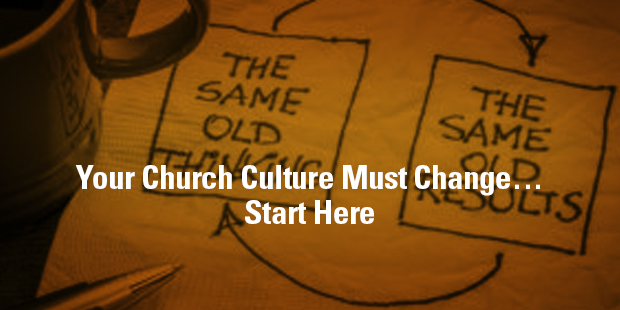
Your Church Culture Must Change… Start Here
The illiterate of the 21st century will not be those who cannot read and write, but those who cannot learn, unlearn and relearn. ~ Alvin Toffler
When bringing about change in the way people behave, we often need to start with questions of “why” before considering the practical issues of “how.” In the book Start with Why, author Simon Sinek contends that there are two primary ways to influence human behavior: you can either manipulate it or inspire it. While manipulation is not always negative (for example when a department store drops the price of a product to motivate a purchase), it often involves the use of fear or peer pressure to influence behavior. Additionally, change that is manipulated is usually short-lived. Inspiring change, on the other hand, involves the consideration of deeper issues. We need to ask underlying questions of “why.” Why do we perceive things in a particular way? Why do we behave in a certain manner? What are the motivations or inherent factors that undergird our behaviors?
In the book Leadership Without Easy Answers, Ronald Heifetz makes a distinction between organizational change and cultural change. Attempts at organizational change typically involve restructuring of some type, along with the use of new programs, processes and techniques. Cultural change, however, looks at how to create a new culture or environment, which will in turn require a completely new set of skills and capacities.
The answer to the crisis of the church in North America will not be found by making minor adjustments in our ecclesiology–how we do church. Instead, the problem is much more deeply rooted. It has to do with the essence of who we are as the church and what we have been called to do. The real issues in the current crisis are primarily spiritual, theological and missiological. To plant disciple-making, missional-incarnational focused churches that have a mind-set of reproduction will take deep cultural change in the way we think about God’s mission and the nature of the church, as well as how the church engages in that mission in local contexts. We must change our attitude from “we have never done it that way before” to “whatever it takes.”
An adage that speaks to the importance of considering change in an organization goes like this: We are perfectly designed to achieve what we are currently achieving. Read that again. We are perfectly designed to achieve what we are currently achieving. If we make application of this statement to the church today, one of the questions we might ask would be: Are we satisfied with what we are currently achieving? In other words, are we content or pleased with the impact the church is having today? If we are totally honest, the answer would seem to be a resounding no. The fact is, regardless of what marker a person looks at to judge the health of the church in North America, every indicator is trending in the wrong direction. If we are perfectly designed to achieve what the church is currently achieving, then shouldn’t we ask if there is an issue in the way we are designed? Or at least question if there is an issue in the way we understand the nature of the church and its place in God’s mission? Do we need to reconsider the way we think about church planting? Are there “design” factors that we need to rethink to achieve the outcomes we desire?
The strategies and techniques that fit previous eras of church history don’t seem to work any longer. What we need now is a new set of tools. We need a new vision of reality, a new paradigm—a fundamental change in our thinking that leads to a fundamental change in our behavior, especially as it relates to our understanding of the church, mission, discipleship and church planting.
Learn more about bringing about cultural change at your church – connect with an Auxano Navigator today!

Tags: Brad Brisco, Church culture, Culture change












